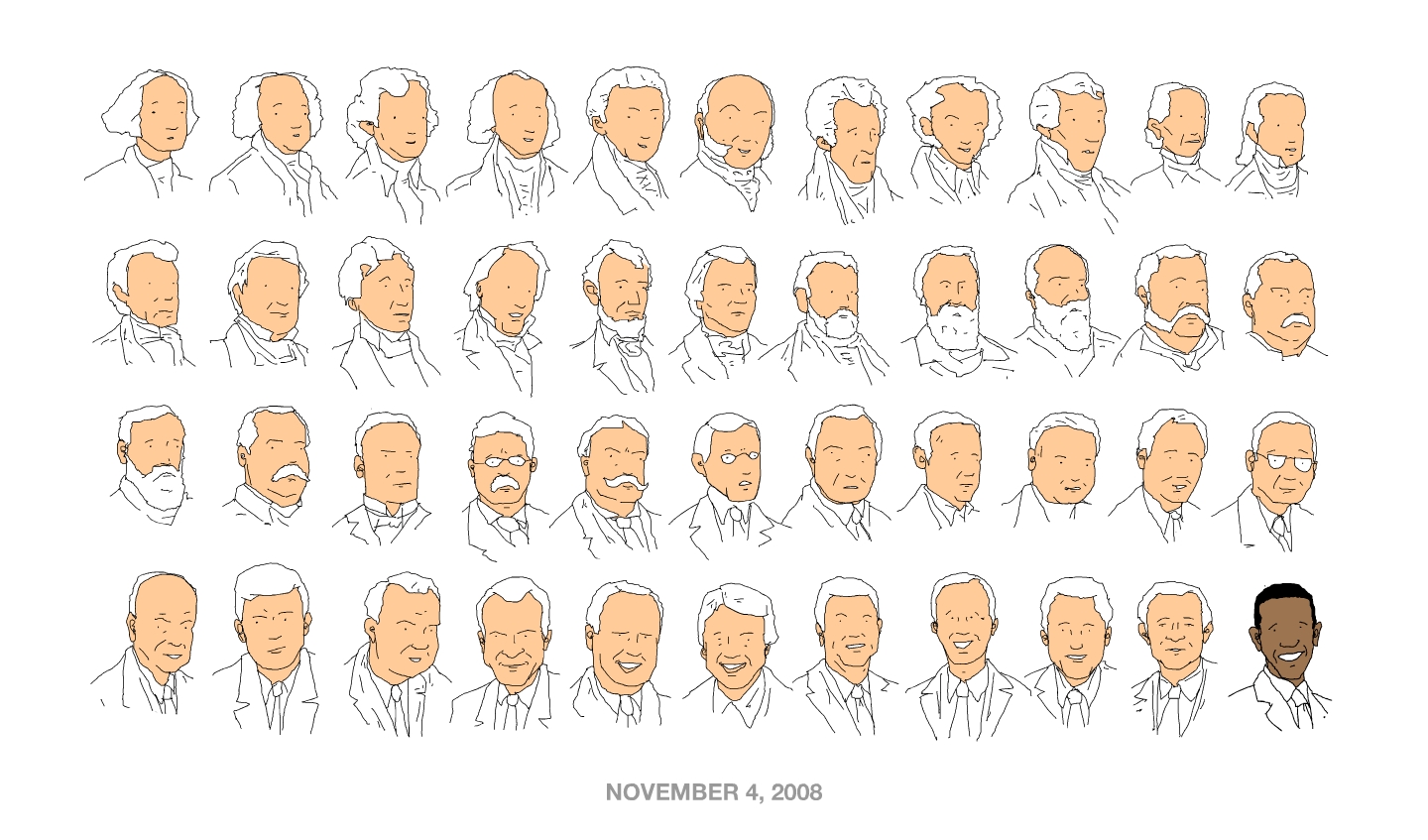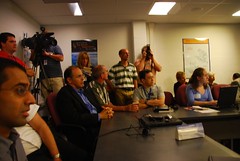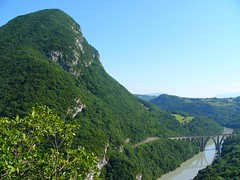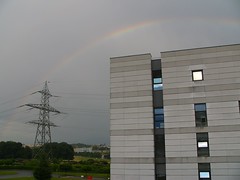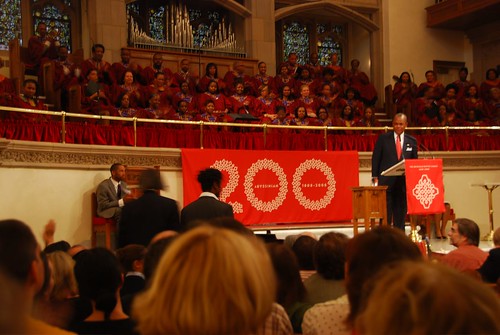 Great workshop so far: fantastic setting and excellent discussions about black holes, QCD, strings, dualities, etc. All the fun stuff, all in one place. Anyway here are some photos. Enjoy.
Great workshop so far: fantastic setting and excellent discussions about black holes, QCD, strings, dualities, etc. All the fun stuff, all in one place. Anyway here are some photos. Enjoy.
Wednesday, December 10, 2008
A Few Days in Stellenbosch
 Great workshop so far: fantastic setting and excellent discussions about black holes, QCD, strings, dualities, etc. All the fun stuff, all in one place. Anyway here are some photos. Enjoy.
Great workshop so far: fantastic setting and excellent discussions about black holes, QCD, strings, dualities, etc. All the fun stuff, all in one place. Anyway here are some photos. Enjoy.
Monday, December 08, 2008
Where The Black Hole Went
 The Economist tells us that "saving seems like pouring money into a black hole." I always wondered what had happened to that black hole we didn't make at the LHC...
The Economist tells us that "saving seems like pouring money into a black hole." I always wondered what had happened to that black hole we didn't make at the LHC...
Saturday, December 06, 2008
Cape Crusaders
 So just as I start to blog a tiny bit, I'm disappearing again for another work trip (and a bit more). This time it's off to Cape Town (well, Stellenbosch, really) for a workshop on "Applications of Gauge/Gravity Duality". It'll be me and a lot of string theorists, where naturally I'll be the token experimentalist. Still, should be a blast in a beautiful place -- and hopefully I'll learn a thing or two, and teach a thing or two. In any case, it's great to have a chance to spread the RHIC gospel. More later.
So just as I start to blog a tiny bit, I'm disappearing again for another work trip (and a bit more). This time it's off to Cape Town (well, Stellenbosch, really) for a workshop on "Applications of Gauge/Gravity Duality". It'll be me and a lot of string theorists, where naturally I'll be the token experimentalist. Still, should be a blast in a beautiful place -- and hopefully I'll learn a thing or two, and teach a thing or two. In any case, it's great to have a chance to spread the RHIC gospel. More later.
Thursday, December 04, 2008
Chance and the Curies

Yesterday, a friend of mine who works for the Cullman Center for Scholars and Writers asked my wife and me to be her guests to hear Lauren Redniss, an artist and writer (nominated for a Pulitzer for her NYTimes Op-Art pieces). It felt like something out of a mysterious teen novel to go to the NY Public Library, amble up the stairs gawking at the high ceilings and stone work, and have to knock to gain entry to the conference room (where they nicely served Dominican food for lunch).
Redniss, who has written/drawn about dancers and chess and people and their lives in New York, is tackling the lives of Pierre and Marie Curie who did pioneering studies in radioactivity (and Marie even coined the term). It is an interesting approach, trying to tie various aspects of their lives to the science they devoted themselves to (and devote themselves they did -- sounds like they didn't get out of the lab much!).
Pierre Curie died in a freak accident in a Paris street, where he tripped and had his skull crushed by a heavily-laden horse-drawn carriage. Redniss related this to the concept of the "normal accident", one which occurs in complex, tightly coupled systems, where one seemly-trivial problem may randomly coincide with another, and their combination may trigger a catastrophe. Turns out that Three Mile Island is the paradigmatic case, a fact that Redniss interestingly ties back to the Curies -- their work having made nuclear power (eventually) possible. She also connected it to the randomness of radiation itself.
The thing that struck me about that latter point was that the randomness of life and the randomness of radioactive processes aren't really the same. The randomness of life is one that emerges out of complex environments, like cities, where many people and things move according to their own agendas and interact (physically, socially, etc). Getting hit by a car is the result of a long causal chain which brought you to that crosswalk, and a different causal chain which brought the car there at the same exact time, and then perhaps another factor which makes you cross against the light etc. The point here is that there is a long, confusing, but nominally well-defined set of events that could in-principle be reconstructed to explain why that accident occurred where and when it did.
But radioactivity (and indeed any quantum mechanical system) is different. As far as we know, quantum mechanical processes like nuclear decay just happen when they happen, and completely at random. The life or death of Schrodinger's cat, and the mystery of the thought experiment relies on this truly random nature of quantum processes. All attempts to reduce quantum probabilities to the deterministic activity of hidden degrees of freedom have failed (see e.g. Bell's Theorem). Thus for all practical purposes, radioactivity is one of the purest examples of irreducibly random behavior existing in nature, and this is no small thing: generating random numbers with computers (e.g. pick a number between one and ten) is a non-trivial thing, and most only make "pseudorandom" numbers at best.
Anyway, I did manage to ask if she had considered this difference in her thinking-through of the story she was trying to tell. Of course I also managed to say that radioactivity was the "only" way that such randomness was manifest in nature, which is obviously wrong. Luckily the roomful of writers, historians, and graphic designers didn't catch me right off. Too bad that a well-known historian of science was also in the room, who did!
Friday, November 07, 2008
Tuesday, November 04, 2008
Hope and Progress and Change
Are you ready? I am. I have a long line to brave at the home for the visually-impaired just around the corner, and then it's getting ready for a physics talk in Israel next week, and following results to check those prediction sites: 538 (O by 6 and change with 346 electoral votes), RCP (7.8%), Princeton (53%/352), inTrade (350). Also keeping fingers crossed for the congressional elections as well.

Thursday, October 23, 2008
Save Italian Physics from Il Buco Nero (The Black Hole)
 I received this from a former colleague of mine, an American who moved to Italy for his scientific career. Normally, I wouldn't forward this, but it's quite alarming (and it involves black holes, in the most negative, and essentially real, way possible):
I received this from a former colleague of mine, an American who moved to Italy for his scientific career. Normally, I wouldn't forward this, but it's quite alarming (and it involves black holes, in the most negative, and essentially real, way possible):Dear friends and colleagues,I can't think of any good reason not to sign, so I did.
I am writing to enlist your support in our protest against new funding cuts and hiring restrictions that threaten the future of Italian research. These new laws were described in a recent article and editorial in Nature (455, pp. 835 and 840). In the specific case of the INFN, these cuts put most of the temporarY staff (including most young researchers) at risk.
I would like to ask you to read and consider signing our petition on our web site:
http://www.buconero.eu
Under the heading "In English" there is much additional background information for the international community (including links to the Nature articles). We would also be greatful if you could bring this issue to the attention of your interested colleagues.
Pong - invented by Nuclear Physicists

This is fantastic:
In 1958, William "Willy" Higinbotham designed what he considered to be a simple electronic game using an analog computer, two clunky metallic controllers and an oscilloscope screen. Named Tennis for Two, his game would become part of the groundwork for a multibillion-dollar industry.
At the time, Higinbotham was a nuclear physicist at Brookhaven National Laboratory in Upton. Looking for a way to draw people to the lab's annual visitors' day, he came up with the concept of the game.
On Friday, the laboratory will celebrate the 50th anniversary of Tennis for Two with a re-creation of the game and a tour of the instrumentation division where it was created. Bob Dvorak Jr. remembers being the first child to play the game.
 I knew this story, but never thought of it before as an equivalent to the WWW being invented at CERN. If this is what physicists do for fun (i.e. spawn multi-billion dollar industries), maybe the world (and specifically the US) should Fund. More. Physics.
I knew this story, but never thought of it before as an equivalent to the WWW being invented at CERN. If this is what physicists do for fun (i.e. spawn multi-billion dollar industries), maybe the world (and specifically the US) should Fund. More. Physics.Anyway there's also this nice article at BNL.
And of course, a video:
Tuesday, October 21, 2008
Fright Night
Yes I saw the Palin cold open on SNL, and I got the point. She's trying to show that she's a good sport, she can face down her critics on their own turf, and so won't seem as lame and out of touch if McCain loses and she needs to go from running for VP to something more manageable, and less dangerous for blue staters everywhere, like Senator of Alaska. But while canny, she did nothing to mitigate my outright fear of her taking power of any sort. Put simply, she freaks me out a bit.
I went canvassing for Obama several weeks ago, and when the good folks in Bucks County, PA asked me why they should vote for Obama, something like this jumped to mind, although I wasn't sure if I was just overreacting -- so it's nice to find out that I'm not alone:
 Her vaulting ambition scares the living daylights out of me.
Her vaulting ambition scares the living daylights out of me.
I went canvassing for Obama several weeks ago, and when the good folks in Bucks County, PA asked me why they should vote for Obama, something like this jumped to mind, although I wasn't sure if I was just overreacting -- so it's nice to find out that I'm not alone:
 Her vaulting ambition scares the living daylights out of me.
Her vaulting ambition scares the living daylights out of me.
Art & Science: All in the Family?
David at symmetry breaking points out the question of musicians (by which he means serious musicians, or at least rich/famous ones) with physicist parents. David's got Mark Everett (whom I wrote about a few years ago) and I've noticed a surprising number of well-known creative children with physicist parents, particularly folks in the motion picture (TV & film) industry:
- Kieslowski muse Irene Jacob (Red, Double Life of Veronique), daughter of Maurice Jacob
- Character actor Josh Pais, son of Abraham Pais
- Pirates of the Carribean director Gore Verbinski, son of Vic Verbinski (nuclear physicist at Oak Ridge)
- TV Star Jon Stewart's (nee Liebowitz) estranged father was apparently a physicist
Sunday, October 19, 2008
A Secret Web
So with K out of town, I ventured a few blocks away to Union Square (after a few Chelsea openings -- more on this later...) to see the Secret Machines at Webster Hall. The latter was an eye-opener it itself, with lurid, outrageous reliefs on the walls, but the band did not disappoint either (although they trended a bit proggy for my tastes in this show). In particular, the stage set was striking, both in how what seemed like inocuous gauze strips attached to plastic piping suddenly transformed into a compelling geometric pattern (Moire, even?) with only a few twists and a few cable ties.
I dug around for a bit and found out that it was designed by Es Devlin, a European set designer: I'm still not sure this tells me exactly what I wanted to know (I didn't associate the word "romboid" with this kind of pattern...), but fun nonetheless. Naum Gabo, eh? The word seems to be "linear construction" but there has to be a more general term for this kind of thing, especially the "fixed" points these twists generate. Live and learn.
I'm still not sure this tells me exactly what I wanted to know (I didn't associate the word "romboid" with this kind of pattern...), but fun nonetheless. Naum Gabo, eh? The word seems to be "linear construction" but there has to be a more general term for this kind of thing, especially the "fixed" points these twists generate. Live and learn.
And I just remembered, I've blogged about these guys before. Feels like a lifetime ago, so I feel even older now.
 And for fun, here's the silk screen poster (I got 87/400), keeping up with the "linear construction" theme. Strange that just a few hours beforehand, I was admiring a set of multi-layer lithographs at a Chelsea gallery by Stefan Kurten. Much more intricate than this, but a neat coincidence.
And for fun, here's the silk screen poster (I got 87/400), keeping up with the "linear construction" theme. Strange that just a few hours beforehand, I was admiring a set of multi-layer lithographs at a Chelsea gallery by Stefan Kurten. Much more intricate than this, but a neat coincidence.
I dug around for a bit and found out that it was designed by Es Devlin, a European set designer:
The visual elements are a direct instinctive response to the qualities of the music. The band will be caught within a Naum Gabo-inspired romboid structure surfaced with gauze and punctuated with radiating tensioned cables which will catch the light in a more lyrical way than a pure saturated block of back light - we might combine them and counterpoint them with pure blocks of backlight too. What the fans see will be a visual expression and counterpoint to what they hear allowing them the space to project their own interpretation of the music and the courage to intensify it.
 I'm still not sure this tells me exactly what I wanted to know (I didn't associate the word "romboid" with this kind of pattern...), but fun nonetheless. Naum Gabo, eh? The word seems to be "linear construction" but there has to be a more general term for this kind of thing, especially the "fixed" points these twists generate. Live and learn.
I'm still not sure this tells me exactly what I wanted to know (I didn't associate the word "romboid" with this kind of pattern...), but fun nonetheless. Naum Gabo, eh? The word seems to be "linear construction" but there has to be a more general term for this kind of thing, especially the "fixed" points these twists generate. Live and learn.And I just remembered, I've blogged about these guys before. Feels like a lifetime ago, so I feel even older now.
 And for fun, here's the silk screen poster (I got 87/400), keeping up with the "linear construction" theme. Strange that just a few hours beforehand, I was admiring a set of multi-layer lithographs at a Chelsea gallery by Stefan Kurten. Much more intricate than this, but a neat coincidence.
And for fun, here's the silk screen poster (I got 87/400), keeping up with the "linear construction" theme. Strange that just a few hours beforehand, I was admiring a set of multi-layer lithographs at a Chelsea gallery by Stefan Kurten. Much more intricate than this, but a neat coincidence.
Thursday, October 16, 2008
Obama v. Einstein
I haven't seen much discussion of science in this campaign season, and this video doesn't really fit the bill either, but I found this discussion cryptic as well, so it's nice to see people thinking out-of-the-box...right?
Saturday, September 20, 2008
Front Page News
Yeah, yeah, $700 billion is a lot of money, but the real front page news is a bit below the fold: Problems Stall Action for Collider. CERN's DG Robert Aymar email to CERN personnel tells the story more precisely:
Incident in LHC sector 34But really, folks: these machines rarely come up quickly and problem-free. RHIC has been running for years, but people never mention that it had a very tough first year, and every start-up each year had its scary moments (including these repairs involving "warm-up" of the superconducting helium, which necessarily take weeks to months). So we should all keep our fingers crossed, but I doubt that it's time to be overly worried at this point.
Dear Colleagues,
During commissioning (without beam) of the final LHC sector (sector 34) at high current for operation at 5 TeV, an incident occurred at mid-day on Friday 19 September resulting in a large helium leak into the tunnel. Preliminary investigations indicate that the most likely cause of the problem was a faulty electrical connection between two magnets which probably melted at high current leading to mechanical failure. CERN's strict safety regulations ensured that at no time was there any risk to people.
A full investigation is underway, but it is already clear that the sector will have to be warmed up for repairs to take place. This implies a minimum of two months down time for the LHC operation. For the same fault, not uncommon in a normally conducting machine, the repair time would be a matter of days.
Further details will be made available as soon as they are known.
Best regards
Robert Aymar
Sunday, September 14, 2008
DFW RIP
 I can't add too much about his importance to fiction in general than the various obits that are appearing as I write, but I can say that for a quite a few years, David Foster Wallace's writing was a guiding presence in my life. Infinite Jest was a beautiful, sprawling mess, but one that got me through my year of thesis writing (e.g. it took me almost half of that year to plow through it), and taught me things about Boston that simply living in Cambridge wouldn't ever achieve (and taught me the fun of the egregious footnote). A Supposedly Fun Thing I'll Never Do Again, among other things, consolidated a lingering fascination with pro tennis that IJ seeded, and made consider the abstract beauty and physical elegance of the sport (and I've still never taken a cruise). Everything and More was a manic trip through the life and work of Georg Cantor that, despite it's verve and love of the subject and vain hope to explain it to the literate masses, made me question the very existence of editors in the publishing industry. And Consider the Lobster made me do just that, although the drastically abridged audiobook iTunes sold me, that got me through quite a few rides back and forth to BNL, made me deconsider it just enough to eat them again.
I can't add too much about his importance to fiction in general than the various obits that are appearing as I write, but I can say that for a quite a few years, David Foster Wallace's writing was a guiding presence in my life. Infinite Jest was a beautiful, sprawling mess, but one that got me through my year of thesis writing (e.g. it took me almost half of that year to plow through it), and taught me things about Boston that simply living in Cambridge wouldn't ever achieve (and taught me the fun of the egregious footnote). A Supposedly Fun Thing I'll Never Do Again, among other things, consolidated a lingering fascination with pro tennis that IJ seeded, and made consider the abstract beauty and physical elegance of the sport (and I've still never taken a cruise). Everything and More was a manic trip through the life and work of Georg Cantor that, despite it's verve and love of the subject and vain hope to explain it to the literate masses, made me question the very existence of editors in the publishing industry. And Consider the Lobster made me do just that, although the drastically abridged audiobook iTunes sold me, that got me through quite a few rides back and forth to BNL, made me deconsider it just enough to eat them again.Needless to say, I'm crushed by his passing. WTF, DFW?
Wednesday, September 10, 2008
A Great Day
BNL Media Event
I'm trying to keep up with this but there's a lot going on today. Have a look at my flickr set if you want to see the fun.
Wrong Way, Google (or, the Googlon)
 Very cute, Google, but the logo shouldn't be going into the collision. That's what a stable, ultramassive black hole would do - and we aren't likely to make any of those (but maybe some of the unstable, microscopic kinds!). Rather, we're looking for things emerging from the collision, like a Higgs boson. That said, if you guys want to put up some funding, I'm sure someone will find something to name for you all: a Googlon, anyone?
Very cute, Google, but the logo shouldn't be going into the collision. That's what a stable, ultramassive black hole would do - and we aren't likely to make any of those (but maybe some of the unstable, microscopic kinds!). Rather, we're looking for things emerging from the collision, like a Higgs boson. That said, if you guys want to put up some funding, I'm sure someone will find something to name for you all: a Googlon, anyone?
Friday, August 29, 2008
Who Are You Going to Call VP?
Did anyone else notice that Sarah Palin, McCain's recently-picked running mate,
 has an uncanny resemblance to
has an uncanny resemblance to
 Annie Potts in Ghostbusters?
Annie Potts in Ghostbusters?
 has an uncanny resemblance to
has an uncanny resemblance to Annie Potts in Ghostbusters?
Annie Potts in Ghostbusters?
Friday, August 22, 2008
Bolt of Genius
 Ever had one of those months? Yeah, me too.
Ever had one of those months? Yeah, me too.Anyway, it's given me more time to read the paper, where I noticed this gem in a Times article about Usain Bolt, the Jamaican runner who shattered the previous 200m record by two one-hundredths of a second, which apparently sets "new parameters on what humans can achieve":
“You have people who are exceptions,” said Stephen Francis, the coach of Bolt’s main Jamaican rival, Asafa Powell, the former 100 world-record holder. “You have Einstein. You have Isaac Newton. You have Beethoven. You have Usain Bolt. It’s not explainable how and what they do.”Who can argue with that, and especially with using two physicists as points of comparison?
Saturday, August 09, 2008
Beam in LHC
 Wow this is really happening, Rama Calaga and Adam Yurkewicz are reporting live on the LHC actually putting beam in the machine. Stay tuned.
Wow this is really happening, Rama Calaga and Adam Yurkewicz are reporting live on the LHC actually putting beam in the machine. Stay tuned.
Saturday, July 26, 2008
Bernese Bat Signal
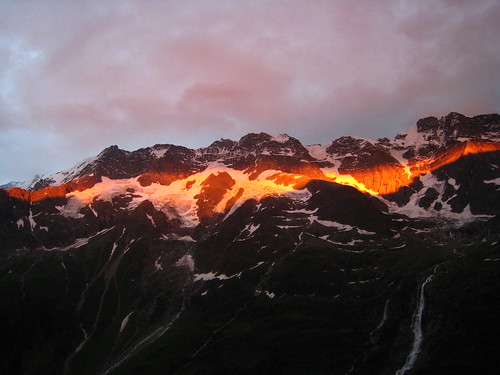 We bumped into this unreal sunset/cloud/mountain configuration up on Obersteinberg in the Bernese Oberland. As I noticed this from our room, grabbed my camera, and bolted outside, everyone from the berghaus started doing the same thing. Then I got home, and noticed this:
We bumped into this unreal sunset/cloud/mountain configuration up on Obersteinberg in the Bernese Oberland. As I noticed this from our room, grabbed my camera, and bolted outside, everyone from the berghaus started doing the same thing. Then I got home, and noticed this: And yes, I saw the movie last night, but didn't see any alpine sunsets anywhere -- just that crazy Joker everywhere.
And yes, I saw the movie last night, but didn't see any alpine sunsets anywhere -- just that crazy Joker everywhere.
Wednesday, July 23, 2008
Bernese Oberland
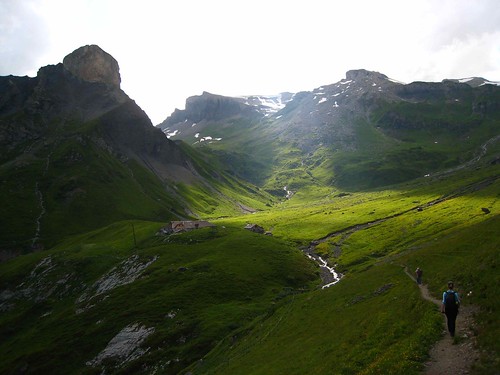 One thing I haven't had a chance to mention yet is that K and I finally took a vacation a few weeks ago, just before my trip to Bern. We managed to hike our way through a bit of the Bernese Oberland, roughly following the Alpine Pass Trail. The photos (or at least the ones we've posted!) can be found here.
One thing I haven't had a chance to mention yet is that K and I finally took a vacation a few weeks ago, just before my trip to Bern. We managed to hike our way through a bit of the Bernese Oberland, roughly following the Alpine Pass Trail. The photos (or at least the ones we've posted!) can be found here.
Taking PHOBOS Apart
One of my BNL colleagues wanted to see these again, so I decided just to go ahead and post them online. These are the most recent photos of PHOBOS in its final incarnation, as it was when we had to take it apart in 2005 and put it in "cold storage" for a few years. You can finally see all of the various pieces of the system we usually show as a CAD drawing in our scientific talks -- the magnet, the silicon, the beampipe, etc. Frankly, while at first glance it looks quite chaotic, I find the silicon detectors themselves alarmingly symmetric and beautiful looking. And incredibly clean, which is unsurprising considering they were safely protected in a light-tight enclosure for 6 years! Enjoy.
Saturday, July 19, 2008
View from Fort L'Ecluse
Still catching up from my long trip. Here are a few photos from an afternoon playing hookey from meetings. An ALICE friend of mine had stumbled onto Fort L'Ecluse years ago, on another hookey trip, and wanted to check it out again. However, this time they'd completely revamped the fort, made it into a museum, and given access to the upper fort (Fort Superieur) 1000 steps in the air. While I hadn't expected a Washington Monument level climb, it was totally worth it for the views (of Mont Blanc, the Rhone, and the Vuache) which happened to be on the most perfect day I'd seen in Geneva for quite a while. Anyway, enjoy.
For those curious, the fort is a drive about 20 minutes southwest of CERN (just between Meyrin and Saint-Genis-Pouilly, straddling the border), at a "notch" in the Jura just below Collonges, which looks like this (thanks, Google):
 So it gives fantastic views towards the Alps to the east, especially Mont Blanc, which features prominently in a few of the photos.
So it gives fantastic views towards the Alps to the east, especially Mont Blanc, which features prominently in a few of the photos.
For those curious, the fort is a drive about 20 minutes southwest of CERN (just between Meyrin and Saint-Genis-Pouilly, straddling the border), at a "notch" in the Jura just below Collonges, which looks like this (thanks, Google):
 So it gives fantastic views towards the Alps to the east, especially Mont Blanc, which features prominently in a few of the photos.
So it gives fantastic views towards the Alps to the east, especially Mont Blanc, which features prominently in a few of the photos.
Friday, July 11, 2008
CERN Rainbow
I know things have been silent on this blog since before I left for Switzerland, but it's been flat out for me since that Wall-E post. First I had to get ready for my trip, which involved a week in the Bernese Oberland, a week in Bern for an ATLAS meeting, and now a partial week here at CERN getting my head around ATLAS itself. Then I had to hike up and down mountains for a week, breathing the cleanest air, drinking the cleanest water, and eating lots of swiss hiking food. I've just finished the week in Bern, which is an unbelievably nice place, especially with the weather. And now I'm holed up in a hostel room at CERN (the CERN hostel being better than many hotels I've seen) waiting out the intermittent rainstorms. Of course with crazy weather comes some crazy luck, like this circular rainbow hovering over Geneva: auspicious, no?
Sunday, June 22, 2008
The BNL of the Future
I totally missed this, but the marketing for the upcoming Pixar film Wall-E has a fake website for a company called "Buy-N-Large", whose acryonym is kind of familiar to me:
 I wonder if anyone at the lab is going to make the connection? Of course, this new BNL has to compete with Banco Nazionale del Lavoro in Italy, and Bare Naked Ladies, and, um, B&L Associates. But the movie seems to suggest that BnL will be all right, especially from the perspective of the far future.
I wonder if anyone at the lab is going to make the connection? Of course, this new BNL has to compete with Banco Nazionale del Lavoro in Italy, and Bare Naked Ladies, and, um, B&L Associates. But the movie seems to suggest that BnL will be all right, especially from the perspective of the far future.
Needless to say, that despite a major work trip coming up the next day, my wife and I will be lining up to catch Wall-E when it opens this week. The NYTimes article yesterday (today?) made sure that resistance would be futile, at least for us.
 I wonder if anyone at the lab is going to make the connection? Of course, this new BNL has to compete with Banco Nazionale del Lavoro in Italy, and Bare Naked Ladies, and, um, B&L Associates. But the movie seems to suggest that BnL will be all right, especially from the perspective of the far future.
I wonder if anyone at the lab is going to make the connection? Of course, this new BNL has to compete with Banco Nazionale del Lavoro in Italy, and Bare Naked Ladies, and, um, B&L Associates. But the movie seems to suggest that BnL will be all right, especially from the perspective of the far future.Needless to say, that despite a major work trip coming up the next day, my wife and I will be lining up to catch Wall-E when it opens this week. The NYTimes article yesterday (today?) made sure that resistance would be futile, at least for us.
Tuesday, June 10, 2008
Physics and Politics
 From 0 to 3 in 15 years is pretty good: “'If we continue to reproduce in this manner,' Mr. Foster began, and Mr. Ehlers finished the thought, 'the entire Congress would consist of physicists!'"
From 0 to 3 in 15 years is pretty good: “'If we continue to reproduce in this manner,' Mr. Foster began, and Mr. Ehlers finished the thought, 'the entire Congress would consist of physicists!'"I actually spent time on Capitol Hill when I was in college, working for a Congressman. Fascinating time, but that was a major inflection point in my life story, when I decided to do science instead -- hoping to avoid some of the messiness of politics in my real life. Of course, do science for a few years and the messiness of it comes roaring back at you: so I really respect these guys trying to roll up their sleeves and interject fact-based reasoning into the policy-making process.
Friday, June 06, 2008
The Four Phases of PHOBOS
 Of course I'm still catching up with last week, partly due to distractions this week, and partly since it took a few days for the organizers to post all of the talks from the RHIC Users Meeting. One talk which was particularly significant to me was "The Four Phases of PHOBOS" by Wit Busza from MIT, who has been spokesman of the PHOBOS experiment at RHIC since its inception in the early 1990s. He was even spokesman before PHOBOS was even a proposal, back when it was a conceptual design called "MARS", shown here to the right, which eventually became the PHOBOS experiment (side note: while MARS was actually an acronym, PHOBOS never was, even if it was presented like one). And he was there all the way through it's first incarnation as a working experiment, even in pieces
Of course I'm still catching up with last week, partly due to distractions this week, and partly since it took a few days for the organizers to post all of the talks from the RHIC Users Meeting. One talk which was particularly significant to me was "The Four Phases of PHOBOS" by Wit Busza from MIT, who has been spokesman of the PHOBOS experiment at RHIC since its inception in the early 1990s. He was even spokesman before PHOBOS was even a proposal, back when it was a conceptual design called "MARS", shown here to the right, which eventually became the PHOBOS experiment (side note: while MARS was actually an acronym, PHOBOS never was, even if it was presented like one). And he was there all the way through it's first incarnation as a working experiment, even in pieces (see left), through its "golden age" from 2000-2005 as a working active experiment (below), and even now as the collaboration is still analyzing the data and writing papers despite the experiment being completely disassembled.
(see left), through its "golden age" from 2000-2005 as a working active experiment (below), and even now as the collaboration is still analyzing the data and writing papers despite the experiment being completely disassembled. In fact, it was also notable that last week was when PHOBOS was finally taken from BNL and brought to MIT by van (see loading photos below), where various sections will be shipped to the participating institutions -- the physics equivalent of a hunting trophy. Of course this is kind of like a hunter mounting a gun on the wall instead of the deer. Too bad you can't put a "perfect fluid" (or whatever) on the wall -- since, although small, we were an active participant in that hunt since the very beginning.
In fact, it was also notable that last week was when PHOBOS was finally taken from BNL and brought to MIT by van (see loading photos below), where various sections will be shipped to the participating institutions -- the physics equivalent of a hunting trophy. Of course this is kind of like a hunter mounting a gun on the wall instead of the deer. Too bad you can't put a "perfect fluid" (or whatever) on the wall -- since, although small, we were an active participant in that hunt since the very beginning.
Monday, June 02, 2008
Bo Diddley
 Bo Diddley, RIP. I saw him in 2004 (where the Times photo was probably taken), at a monstrous garage rock festival on Randall's Island, impressive as ever, with a guitar I could scarcely imagine without seeing it myself, with so many knobs, sliders, levers, and controls. Too bad no-one ever figured out how to patent a beat back in the 1950's -- he'd have died a rich, rich man.
Bo Diddley, RIP. I saw him in 2004 (where the Times photo was probably taken), at a monstrous garage rock festival on Randall's Island, impressive as ever, with a guitar I could scarcely imagine without seeing it myself, with so many knobs, sliders, levers, and controls. Too bad no-one ever figured out how to patent a beat back in the 1950's -- he'd have died a rich, rich man.
Sunday, June 01, 2008
The Gospel According to Oliver
It was hard to know what exactly to expect from this event, where Oliver Sacks was guest speaker at the Abyssinian Baptist Church up on 138th Street in Harlem as part of the World Science Festival. But pairing a short, but substantial talk by Sacks about "Music and the Brain", with a full-on gospel concert by the Abyssinian Gospel Choir, and introductions by Calvin O Butts III, an impressive speaker in his own right, made for a stellar evening. Brian Greene even gave a star turn doing his best impression of a Baptist preacher, and then took off for his Guggenheim gig downtown (anyone see that?). Even better, I had a Quantum Diarist sighting -- that's Stephon Alexander standing in the front with Jim Gates (who also was part of the Gugg event), as they were acknowledged by Butts during his introduction.
UPDATE: The TED blog has asked if they could use my photo for their report on the same event.
Saturday, May 31, 2008
Dept. of Shamelessness, Part II
And before things accelerate again, just wanted to pass along a couple more pieces of good news. On Thursday, during the RHIC/AGS Users Meeting (yes it ran all week), two things happen that don't normally Happen To Me: a certificate of appreciation for helping bring the BNL Cafe in reality (I'm still blushing -- all I wanted was a cup of coffee), and I survived the election to win a seat (one of several) to the Users Executive Committee. Growing up, I never really thought of myself as community-minded, but something seems to have changed in the last few years. Brookhaven is a lovely place, and RHIC a great place to work, and it's been fun to take a more active role in keeping it that way.
Moscow on the Moskva

Friday, May 30, 2008
Entropy Bound in Physics World
 From the department of shamelessness, I submit to you an article in Physics World about this very blog. Really flattering that it exists at all, but gee it's sobering to hear an outside view of things (i.e. I only saw the piece today, after it had gone live)
From the department of shamelessness, I submit to you an article in Physics World about this very blog. Really flattering that it exists at all, but gee it's sobering to hear an outside view of things (i.e. I only saw the piece today, after it had gone live)
Thursday, May 29, 2008
Thank You (Faputtinme on the NYTimes Website)
 Sly Stone is one of my favorites, and this is my favorite period of his career. And his 1973 expression, surrounded by the ephemera of the modern web, is priceless.
Sly Stone is one of my favorites, and this is my favorite period of his career. And his 1973 expression, surrounded by the ephemera of the modern web, is priceless.
The PHOBOS Glauber Monte Carlo
 As a follow up to this post, several colleagues and I just posted a paper to the arxiv today: "The PHOBOS Glauber Monte Carlo." This is one of those technical-sounding things, but which has had a surprising relevance to understanding actual RHIC data. Many people treat nuclear collisions by considering the nuclei to be overlapping smooth distribution of protons and neutrons. However, it is also reasonable to treat nuclei as clumps of protons and neutrons as individual particles, especially since that's, um, what they are. The interesting part is that the positions jiggle around collision to collision, and those fluctuations seem to have real manifestations in physical phenomena (see, e.g., this paper).
As a follow up to this post, several colleagues and I just posted a paper to the arxiv today: "The PHOBOS Glauber Monte Carlo." This is one of those technical-sounding things, but which has had a surprising relevance to understanding actual RHIC data. Many people treat nuclear collisions by considering the nuclei to be overlapping smooth distribution of protons and neutrons. However, it is also reasonable to treat nuclei as clumps of protons and neutrons as individual particles, especially since that's, um, what they are. The interesting part is that the positions jiggle around collision to collision, and those fluctuations seem to have real manifestations in physical phenomena (see, e.g., this paper). Anyway, there is an amusing back story here: when we were writing one of the early PHOBOS papers back in 2000, we discovered that we needed our own implementation this kind of thing. I was on a trip to South Africa at the time, so I cobbled something together on the plane -- and this is the core of what we've now put out for public release almost 8 years later. That said, it's not rocket science (i.e. every experiment has their own version), but despite a ream of papers and Glauber reviews, there have been relatively few codes available until now. Enjoy.
Wednesday, May 28, 2008
The Physics of Privacy
Fantastic -- an anonymous donor has recently stepped up to contribute $5 million to Fermilab (via the University of Chicago) to help end its furloughs.
It's incredible that Congress as a whole still does not appreciate the intrinsic interest high energy and nuclear physics generate outside the field. RHIC already showed that private funding actually makes both sides look good: the donor for supporting something which promotes science and technology, and participating in the process of discovery, and the scientists for attracting the attention of powerful people outside the government. While it clearly will never be enough to rely on private donors, it bodes well for the future of the field.
RHIC Users Meeting
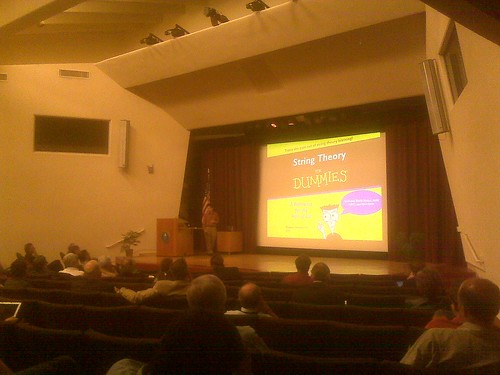 Gee it's been a longer hiatus than expected. First was that trip to Russia. Then it's been madness finishing a proposal (more on that soon). Then it was memorial day weekend and a trip down to the Chesapeake bay. And now it's the RHIC Users Meeting at Brookhaven. We've already had a full day of workshops (I attended one on various correlation measurements used to characterize jets in heavy ion collisions) and now it's an all day symposium on RHIC and its impact on Nuclear Physics. So far nothing brand new to report, but the day has just begun.
Gee it's been a longer hiatus than expected. First was that trip to Russia. Then it's been madness finishing a proposal (more on that soon). Then it was memorial day weekend and a trip down to the Chesapeake bay. And now it's the RHIC Users Meeting at Brookhaven. We've already had a full day of workshops (I attended one on various correlation measurements used to characterize jets in heavy ion collisions) and now it's an all day symposium on RHIC and its impact on Nuclear Physics. So far nothing brand new to report, but the day has just begun.
Thursday, May 08, 2008
Bait and Switch
I've been thinking a bit about Kelly McMaster's book about Shirley, her hometown just a few miles south of BNL, and the air of mystery she tries to generate about the lab where I work, a sense which she passes on to those who listen to and interview her (and who often have never been out there).
The main disconnect I sense with her argument (and full disclosure: I haven't read the book yet, but have only heard interviews and read some of her writing online) is between her sense of wonder about the lab as a child, with her fear and loathing of it as an adult.
The wonder, from her Mother Jones piece:
I gravitated toward a scientific life with fantasies of sci-fi movies running through my head, with large machines emitting lightning at the flip of a huge Frankenstein-type switch, or several people poring over softly-glowing computer screens as an experiment produces fantastic data in real-time, and great discoveries are made. I thought this kind of thing actually happened even as I started grad school (even if I had never seen it in my various research summers...)
Unfortunately, the gap between fantasy and reality is as large as the gap between a scientific experiment and comprehending its implications. Things always take a long time to get started, a long time to happen, and a long time to understand, and often involve false starts, misundertandings, mistakes, retries, etc. This is because we have to constantly test our hypotheses against what we observe in the world around us, either through our own experiments or by scouring the literature (which also takes forever) for similar results. Kind of like a journalist, come to think of it. Bottom line is that the daily work of the scientific life just isn't as colorful -- or ever as sinister -- as McMasters seems to imagine (the conferences and talks etc are another matter -- fun as can be).
That said, maybe I speak as someone who is officially allowed to enter my lab on a daily basis (a privilege I share with 2500 other employees, less than 1000 being scientists, I should add). I suppose if you are put off by the fact that someone at the gate asks who you are, then you might wonder if the lab is hiding something, and develop a sense of mystery to justify one's feeling as an outsider. Then again, you might not have noticed that they have public lectures and musical recitals (always open to the public) almost every week. But it's possible that I only perceive the friendly-and-open side of things -- some bias of this sort is unavoidable, it seems.
So the child in me always wishes someone would take me to the secret parts of the lab --where the lights are flashing, and lightning strikes, and green goo runs out of a vat into the ground, i.e. where the wild things are. But maybe no-one seems to know where they are anymore -- or maybe they aren't there, and were never there. Or maybe I've just grown up a bit and actually taken a look around.
But when you get down to it, it's a bait-and-switch: when you are growing up, no-one ever tells you that things aren't so colorful and mysterious, so by the time you finally realize that it's not, you've found a much more interesting -- albeit prosaic --real world to ponder.
The main disconnect I sense with her argument (and full disclosure: I haven't read the book yet, but have only heard interviews and read some of her writing online) is between her sense of wonder about the lab as a child, with her fear and loathing of it as an adult.
The wonder, from her Mother Jones piece:
As a child, I imagined the lab’s buildings were made of an igloo-like substance, and the rooms inside were full of metallic file cabinets, clinking glass test tubes, and notebooks full of secret codes. Men and women in crisp white lab coats and plastic goggles coaxed new species of frogs and lizards out of mottled purple eggs. Others hovered over milky glass globes of light whose kinked antennas sparked blue shots of electricity into the dim, silent air.And the loathing, in the same paragraph:
My neighbor worked as a maintenance man at the lab, and he often teased that he glowed in the dark. After he died of brain and lung cancer, my imaginary lab became a much darker place—a small, sinister pocket hiding in the pines.The strange part for me is that I can identify with the disconnect between the childhood fantasy and the adult reality, but mine is a different trajectory than hers (and don't assume I'm unaware of the emotional trauma of a close loved one with cancer).
I gravitated toward a scientific life with fantasies of sci-fi movies running through my head, with large machines emitting lightning at the flip of a huge Frankenstein-type switch, or several people poring over softly-glowing computer screens as an experiment produces fantastic data in real-time, and great discoveries are made. I thought this kind of thing actually happened even as I started grad school (even if I had never seen it in my various research summers...)
Unfortunately, the gap between fantasy and reality is as large as the gap between a scientific experiment and comprehending its implications. Things always take a long time to get started, a long time to happen, and a long time to understand, and often involve false starts, misundertandings, mistakes, retries, etc. This is because we have to constantly test our hypotheses against what we observe in the world around us, either through our own experiments or by scouring the literature (which also takes forever) for similar results. Kind of like a journalist, come to think of it. Bottom line is that the daily work of the scientific life just isn't as colorful -- or ever as sinister -- as McMasters seems to imagine (the conferences and talks etc are another matter -- fun as can be).
That said, maybe I speak as someone who is officially allowed to enter my lab on a daily basis (a privilege I share with 2500 other employees, less than 1000 being scientists, I should add). I suppose if you are put off by the fact that someone at the gate asks who you are, then you might wonder if the lab is hiding something, and develop a sense of mystery to justify one's feeling as an outsider. Then again, you might not have noticed that they have public lectures and musical recitals (always open to the public) almost every week. But it's possible that I only perceive the friendly-and-open side of things -- some bias of this sort is unavoidable, it seems.
So the child in me always wishes someone would take me to the secret parts of the lab --where the lights are flashing, and lightning strikes, and green goo runs out of a vat into the ground, i.e. where the wild things are. But maybe no-one seems to know where they are anymore -- or maybe they aren't there, and were never there. Or maybe I've just grown up a bit and actually taken a look around.
But when you get down to it, it's a bait-and-switch: when you are growing up, no-one ever tells you that things aren't so colorful and mysterious, so by the time you finally realize that it's not, you've found a much more interesting -- albeit prosaic --real world to ponder.
Tuesday, April 29, 2008
The Raw and the Cooked
 Hm, my brain is shutting down now, since I just finished giving a long workshop talk here at BNL. The talk is linked above and is not a new topic for me (whether or not the initial state of a RHIC collision is smooth or lumpy, kind of like the green stuff in the image above). Still, it was a nice chance to highlight a relatively new paper we just had published in Physical Review C, and a great chance to catch up with colleagues who really like this stuff.
Hm, my brain is shutting down now, since I just finished giving a long workshop talk here at BNL. The talk is linked above and is not a new topic for me (whether or not the initial state of a RHIC collision is smooth or lumpy, kind of like the green stuff in the image above). Still, it was a nice chance to highlight a relatively new paper we just had published in Physical Review C, and a great chance to catch up with colleagues who really like this stuff. I know it sounds very academic, but it's not (I know I doth protest too much). When you try and "run the movie backwards", starting from this,
 it's important to consider various scenarios of how things looked just as the collision occurred, and not just at the end of the day, when the particles arrived for your perusal.
it's important to consider various scenarios of how things looked just as the collision occurred, and not just at the end of the day, when the particles arrived for your perusal.
Why Black Holes are Good For You
While I wouldn't want to eat one, they clearly make you think about many issues -- some scientific, and these days even moral. But some think more clearly and explain things more generously than others.
The only involvement I can claim with this excellent post by Sabine on Backreaction is finally pushing her over the edge (with this) to blog in public about her take on the non-dangers of black holes, micro or not. It's a great read -- with something to say to many people, including the folks in the media who have really been milking the doomsday story dry.
But who the heck made this crazy video of the earth being swallowed by a fictional black hole Beyond a certain point this goes beyond speculation, and becomes manipulative demagoguery.
The only involvement I can claim with this excellent post by Sabine on Backreaction is finally pushing her over the edge (with this) to blog in public about her take on the non-dangers of black holes, micro or not. It's a great read -- with something to say to many people, including the folks in the media who have really been milking the doomsday story dry.
But who the heck made this crazy video of the earth being swallowed by a fictional black hole Beyond a certain point this goes beyond speculation, and becomes manipulative demagoguery.
Friday, April 25, 2008
Half

Hm. Maybe MC knows something Stephen Hawking missed, as suggested by his (relatively famous) quote:
Although equations are a concise and accurate way of describing mathematical ideas, they frighten most people. When I wrote a popular book recently, I was advised that each equation I included would half the sales. I include on equation, Einstein's famous equation, E=mc2. Maybe, I would have twice as many copies without it.Maybe someone can construct an empirical test of this phenomenon?
And #1 hit record or not, shouldn't this have come out in 2005?
Thursday, April 24, 2008
From a Racetrack to The Cold War Near Home
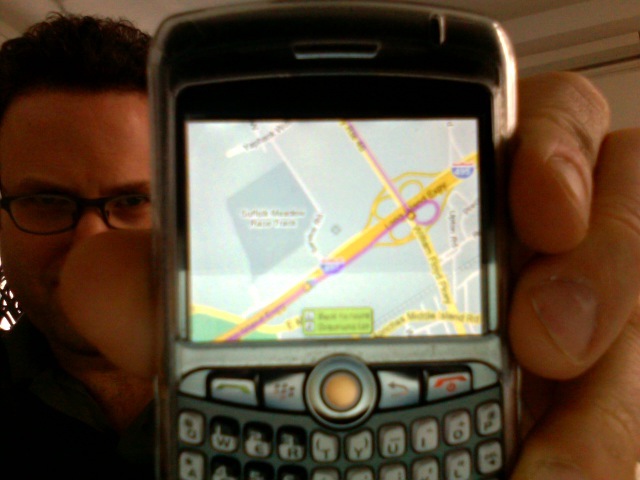 Funny how there are often amazing things around you, and you never notice until you trip over them. I was chatting with a colleague today about how one could improve the commute to Brookhaven from NYC, and I started looking at Google maps to see how close the LIRR tracks came to the lab (a man can dream about a new train station just where he wants it, right?). Then my network connection at home collapsed briefly (my mom is in town so I am telecommuting today), and I resorted to my ever-lovin' Google Maps Mobile on my Blackberry Curve (no iPhone for me, yet). And lo, what did I see there -- and not on the normal version -- but "Suffolk Meadow Race Track", just southwest of the lab. A little Googling got me to the interesting "Long Island Oddities" site, which has this neat article about the honest-to-god horserace track, which was open from 1977 to 1988.
Funny how there are often amazing things around you, and you never notice until you trip over them. I was chatting with a colleague today about how one could improve the commute to Brookhaven from NYC, and I started looking at Google maps to see how close the LIRR tracks came to the lab (a man can dream about a new train station just where he wants it, right?). Then my network connection at home collapsed briefly (my mom is in town so I am telecommuting today), and I resorted to my ever-lovin' Google Maps Mobile on my Blackberry Curve (no iPhone for me, yet). And lo, what did I see there -- and not on the normal version -- but "Suffolk Meadow Race Track", just southwest of the lab. A little Googling got me to the interesting "Long Island Oddities" site, which has this neat article about the honest-to-god horserace track, which was open from 1977 to 1988. 
But then I saw "NIKE Missile Base", which led to this piece about an honest-to-god anti-aircraft missle base in Rocky Point, about 7 miles North of the lab. From there, the research is straightforward, given all of the cold war buffs out there who seem to be keeping the Wiki pages complete. It seems the program ended in 1974, with the SALT I treaty, and now it's a ball field and low-income housing. That said, I'm still not absolutely sure the Nike missiles housed here were actually nuclear (although it was certainly an option for the Hercules), but I'm really staggered to hear about a missile site so close to home.
Monday, April 21, 2008
A Passover Talk
 Happy holidays, everyone. Hectic weekend, with two seders to attend -- one of them even assigning homework, to present to the other guests. Unable to resist the assignment, and unable to do anything without visuals, I found myself analyzing a passage from Exodus -- one about the covenant with Abraham, and how it is "remembered" by God just before the Exodus story gets rolling -- by means of a fairly ornate Keynote presentation. Most interestingly, I found a connection to a neat etching I saw recently by Roman Opalka, a French-Polish artist who seems to have a real thing for recursion. Anyway, have a look and let me know if you have any questions.
Happy holidays, everyone. Hectic weekend, with two seders to attend -- one of them even assigning homework, to present to the other guests. Unable to resist the assignment, and unable to do anything without visuals, I found myself analyzing a passage from Exodus -- one about the covenant with Abraham, and how it is "remembered" by God just before the Exodus story gets rolling -- by means of a fairly ornate Keynote presentation. Most interestingly, I found a connection to a neat etching I saw recently by Roman Opalka, a French-Polish artist who seems to have a real thing for recursion. Anyway, have a look and let me know if you have any questions.
Subscribe to:
Comments (Atom)

